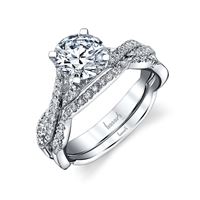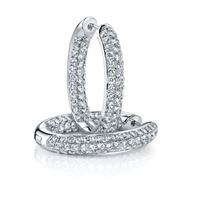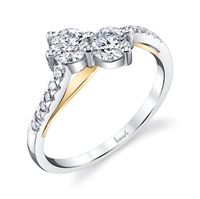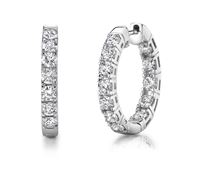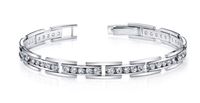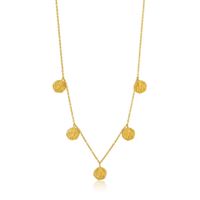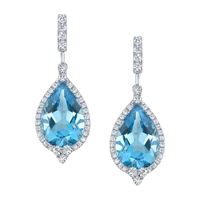Education & Quality
Diamond Education: the 4 C's
At Husar’s House of Fine Diamonds, we will personally help you hand-select the perfect diamond! We want you to be comfortable with every aspect of your experience, which is why we fully educate you on the 4 C’s – Cut, Color, Clarity, and Carat before you make that important decision.
1. Diamond Cut
Cut is the most important aspect of diamond beauty. It is the only factor controlled by man, but for many years it has been the least discussed.
Cut refers to more than just a diamond's shape. It refers to more than depth, table, polish and symmetry. A diamond's cut quality depends on physical measurements called proportions as well as light performance. This combination will determine how well the diamond will sparkle and reflect light.
Cut quality is the most important information about a diamond, but many establishments will not discuss the proportions or grade for cut. The most common grading labs used by diamond sellers provide some details on cut proportions, but not enough to determine the actual cut quality.
Notice when you are shopping that there are grades for color and clarity, but not for cut. Without the missing details a diamond cannot be properly evaluated and cannot be measured against already established cut grades. A person doesn't need to know every last number to make a good decision, but understanding cut grading allows a more informed and confident decision.
 Husar's House of Fine Diamonds uses the American Gem Society (AGS) grading standard for cut. The AGS grades the cut of round diamonds and some fancy shapes with Proportion and Performance scores from 0 (Ideal) to 10. This system takes into account 11 factors: brightness, dispersion, leakage, contrast, girdle thickness, culet, weight ratio, durability, tilt, polish and symmetry.
Husar's House of Fine Diamonds uses the American Gem Society (AGS) grading standard for cut. The AGS grades the cut of round diamonds and some fancy shapes with Proportion and Performance scores from 0 (Ideal) to 10. This system takes into account 11 factors: brightness, dispersion, leakage, contrast, girdle thickness, culet, weight ratio, durability, tilt, polish and symmetry.
The AGS cut grading system is more sophisticated and less forgiving, therefore consumers looking for the finest cut craftsmenship prefer the AGS grading standard. We use both methods, Proportion assessment and Performance assessment, to analyze our diamonds.
Proportion assessment utilizes a 2-dimensional approach that takes the outer measurements of a diamond and predicts how it will handle light. Performance assessment measures the actual light output of the diamond and compares it to established standards.
Angular Spectrum Evaluation Tool (ASET)
In 2005, the AGS introduced a tool, the Angular Spectrum Evaluation Tool or ASET. Based on a similar principal, the ASET shows light return with greater detail as light is color-coded 3 ways. Blue (obscuration contrast), red (high angle, high intensity light return), and green (lower angle, lower intensity light return).
Diamond performance has traditionally been described in terms of brilliance, fire and scintillation. Brilliance or Brightness refers to the total amount of light returning from the diamond. Fire or dispersion, is the degree to which light is broken into spectral colors. Scintillation is sparkle - a dynamic effect associated with movement. In recent years other descriptors have been added to enhance our understanding of diamond's visual properties: Contrast and Pattern describe the arrangement of light and dark areas resulting from reflections. Leakage describes areas that do not reflect light back to the viewer. Methods of performance assessment measure the light output of a diamond and compare it to established standards.
AGS Traditional Ideal Proportions
In 1919 Marcel Tolkowsky, a mathematician and diamond cutter, calculated a set of proportions for the 'Ideal' round diamond. A round diamond cut near these proportions will do a better job of dazzling us with its beauty than one that is not. Those measurements remain a standard by which the world's finest diamonds are judged and logically formed the basis for the first cut grade system by the American Gem Society Laboratory in 1996. As laboratories develop new systems we know that other well-cut configurations are possible, but Mr. Tolkowsky's work has been largely validated by modern science, and is still used today. Over time, AGS has evolved to a performance assessment system with cut grading extended to certain fancy shapes as well. The AGS 'Traditional Ideal' proportions chart is still used as a reference for round diamonds.

The Pyramid of Cut
The AGS and GIA approach cut grading differently, but both are proven systems. Diamonds awarded the top grade by these labs are near the top of what we call the "Pyramid of Cut."
The AGS system is very strict. Less than 3% of the world's round diamonds can earn the AGS top grade of 0 or 'Ideal.' The AGS Ideal grade is considered very elite. The GIA's top grade of 'Excellent' allows for a range that is broader but still an assurance of good quality. A diamond earning one of the AGS top grades has above average cut quality and more importantly, will have passed all tests for depth, durability, polish and basic symmetry. It will also have the most sparkle and brilliance compared to average diamonds.
Summary
If you are shopping on the Internet, finding diamonds with traditional Ideal proportions is a fast way to locate good candidates. Then you can narrow down the field by examining Light Performance, and reflector images to see which has the best light return. However, your own two eyes should serve as final confirmation that you have made a great choice.
ASET images are reliable, lab-endorsed methods of interpreting performance potential in a diamond. We strongly believe in this form of grading, as it is a direct measure of the actual light performance. Remember that if you are looking in retail stores, you should expect the same assessment data and documentation. With every Husar diamond purchase, we will include a certificate detailing both the proportions and the ASET image of your diamond.
2. Diamond Color

Even though they are transparent, most diamonds contain some hint of color. The color comes from Nitrogen that is in the earth, where the diamond was formed. Diamonds can range from colorless to a bright yellow, and can even be different shades of pink, brown, or blue. These colors are known as "Fancy" and are not graded on the same scale.
The only means of determining the true color of a diamond is by using a set of Master Diamonds certified by the American Gem Society. We also use the world's best diamond colorimeter to ensure the accuracy of the diamond's color grade. Staying on the cutting edge of technology is just one of the ways we provide you with top-notch service.
To grade a diamond for color, you should view it from the side and against a white background, comparing it to the Master Diamonds certified by the American Gem Society.
Color and Photos
If you are shopping on the Internet, you cannot make color determinations by images or photos. It's best to speak with a trusted jeweler, and view the actual diamond with your own eyes.
Color and the influence of CUT
Diamond color may be influenced by the shape and quality of it's cut. A round diamond is the most efficient shape for returning light, and if it is cut correctly, the sparkle will mask the color of the diamond better than any other shape.
We set ourselves apart from many other jewelers because we have both the experience and the equipment to distinguish among diamond's subtle color variations - so we can confidently assure you of a diamond's value. We'll show you our Certified Color Master Diamonds under color-corrected lights and with every purchase, we include a certificate detailing your diamond's exact color, cut, clarity, and carat weight.
3. Diamond Clarity
Clarity is the presence or absence of tiny internal or external characteristics or markings. These markings - including feathers, clouds, cavities, and the presence of crystals within a diamond - make every diamond unique and are often invisible to the naked eye.
We individually grade each diamond for clarity using a 10x diamond microscope. If the 10x magnification doesn't reveal internal markings, then the diamond earns the very rare flawless grade and is more valuable. One of our Certified Gemologists examine every diamond, and will assign the diamond a clarity grade and plot the diamond's markings for identification purposes. We also grade diamonds by the naked eye. If an internal marking is visible to the unaided eye, it is possible for the clarity grade to drop down even lower on the clarity scale. The presence of an internal marking doesn't mean that a diamond isn't a quality diamond... since most diamonds have some internal markings. They are what make your diamond unique, a symbol of "Mother Nature's fingerprint."
At Husar's House of Fine Diamonds, you can be sure we'll present you with all the facts so you can make an informed decision when purchasing your diamond. And with every diamond purchase, we'll include a certificate which details your diamonds internal markings and every other aspect of the diamond grading process.

4. Diamond Carat Weight
The weight of a diamond is expressed in carats. This term comes from ancient times when gems were weighed against the carob bean. One carat is equal to 200 milligrams, or one fifth of a gram.
Carat weight (ct) is sometimes expressed in points. One point equals 1/100th of a carat, so 25 points is equal to a quarter of carat and 50 points is equal to half of a carat. Grains of rice were also used. 4 grains of rice were equal to a carob bean. That’s why people sometimes call a quarter carat diamond a one grainer.
Carat Weight and Cost
As carat weight gets larger the value and price of the diamond increases disproportionately. This is because pieces of rough material are increasingly rare with size. Over a million smaller pieces of rough must be mined to find one piece large enough to produce a 1 carat finished diamond. This means that a diamond twice as large as an identical quality, smaller one may be three or more times as expensive, depending on the market.
Carat Weight and Cut
Carat weight is not the same thing as size. As diamonds increase in weight their apparent size becomes less predictable. Diamonds cut too shallow may appear larger than they should, while diamonds cut too deep may look smaller. Too shallow and too deep are both undesirable. A well-cut diamond will appear larger than other diamonds of the same carat weight and spread because of the increase in brilliance.



